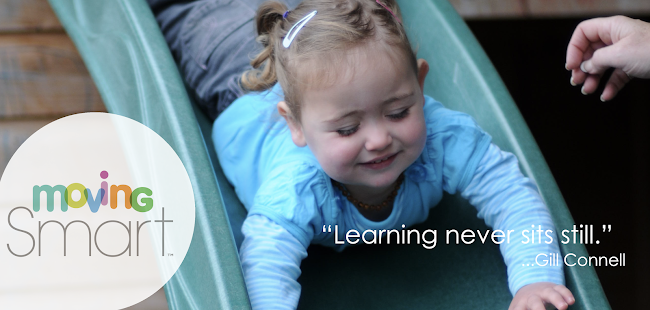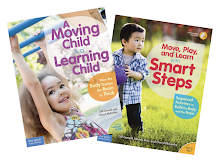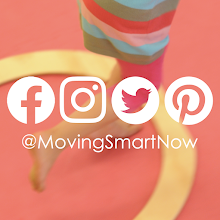The other day I was speaking to a mom of a six year old who was beside herself because her little one uses his fingers to follow the words on the page when reading. She asked if this suggested a developmental delay or if she should be looking for a reading tutor for her son. Here was my answer...
In a word, NO.
So here's the deal.
PHYSICALIZING LEARNING
Children learn with their bodies first, so why should reading be any different? The common wisdom is that children should read with their eyes only and, for that matter, keep their fingers out of the counting. But this ignores the fact that young children learn just about everything else kinesthetically.
For early readers, the fingers often form a little scouting party for the eyes, helping keep the eyes on track and flowing from one word to the next. This actually helps him focus on the meaning of the words rather than on the physical mechanics of moving his eyes from one word to the next. As his eye muscles mature and become more familiar with the experience, they will naturally grow in proficiency and his fingers will no longer be needed.
Likewise, counting on his fingers is his brain’s way of physicalizing numeracy – a natural, multi-sensory entry into the amazing world of mathematics. And again, when he’s mastered counting, chances are he won’t need his fingers any more. And even if he does from time to time, it’s just his way of dimensionalizing and deepening the learning.
EYE/HAND DEVELOPMENT
This is a great example of why eye tracking and eye/hand coordination are important to develop in the early years of life. Eye tracking, of course, is a necessary physical skill for reading... moving the eyes in a deliberate, and disciplined manner. And you can see it happening naturally as your child grows. For instance, when a child watches a balloon floating away, you might see him point up into the sky. This is his way of helping his eyes stay focused on the balloon.
Later on, the eyes will serve as the director for your child's best learning tools... his own hands. Now this takes a lot of time and practice and little ones make a lot of mistakes along the way (spilled milk, anyone?). And again, you'll see it happening every day. For instance, try batting a balloon to your little one and you might see him shut his eyes tight as the balloon comes towards him. Or, if his eyes are open, his might entirely miss catching it because his hands are splayed out and not in position for the catch. With time and practice, he will be able to bring his eyes and hands together at will and do so without having to think about it. When that happens, his eyes and hands are now the tools he'll use for other, larger, deeper, and more complex pursuits... like reading.
CATCH THAT BALLOON!
Next time you've got a balloon around the house, try catching it in all sorts of fun ways. For instance...
Catch it up high.
(hands above your head)
Catch it down low.
(hands below your knees)
Catch on your thumb.
Catch it on your toe!
SITTING
Catch it with your wrists.
Catch it with your knees.
Catch it with your elbows.
Bounce it one, two three!
(bounce on the tips of your fingers)
LYING DOWN
Catch it on your nose.
Catch it with your feet.
Catch it on your tummy.
Catch it with your seat!

















Great post, as usual. Very informative. It makes me sad that a mom would think that points to a delay. There is so much stress on parents right now...in trying to push kids too hard, the parents are being pushed as well. It's a lot of stress all around.
ReplyDeleteGreat post. It raises the question as to why we are not ok with adults doing the same. Plenty of adults who struggle with literacy and numeracy who may fare better if there was not a stigma to using your fingers when you need to!
ReplyDeleteBubbles,balloons and other toss/catch activites are great for developing trackign and eye hand corodination needed for reading, but don't rule out a visual problem if a child continues to lose her oplace while reading, skips words or complains of eye strain. many children have undetected problems with near range focus, convergence and eyes working together (teaming). Evaluation with a developmental optometrist can rule out impairments. Also, there are many adaptations that may help-like underlining or highlighting words, using graph paper and more.
ReplyDeleteBarbara Smith,M.S., OTR/L
FromRattlestoWriting.com
Thanks for your comments, Barb. Completely agree that if parents or educators sense an on-going pattern such as you describe, developmental (or what we behavioral) optometry would be recommended.
ReplyDeleteOnce again, I learn something new from you. Thank you so much for your insights. I gave you the Liebster Award on my blog today!
ReplyDeletedisagree whoelheartedly on the finger-tracking while reading, as well as the use of fingers for counting purposes. just a philosophical difference.
ReplyDeleteThe balloon catch is brilliant I will implement it ASAP into my learning module.
Totally agree with you, and am very surprised that anyone wouldn't. It helps so much with tracking left to right and one-to-one correspondence needed for early learning. I begin early with my infants with pointing to the words. Current research is indicating that teachers NOT pointing to the words during group reading is contributing a lack of literacy, especially in at-risk children. It is recommended that preschool teachers routinely point out at least a few of the words in each book so that children begin to associate the written word with the spoken, rather than just paying attention to the picture. Children naturally lose the finger when they are ready, just like training wheels.
ReplyDeleteI love to add movement to my lessons! I love that shared with me wonderful reasons why I should.
ReplyDelete